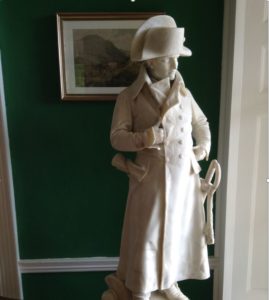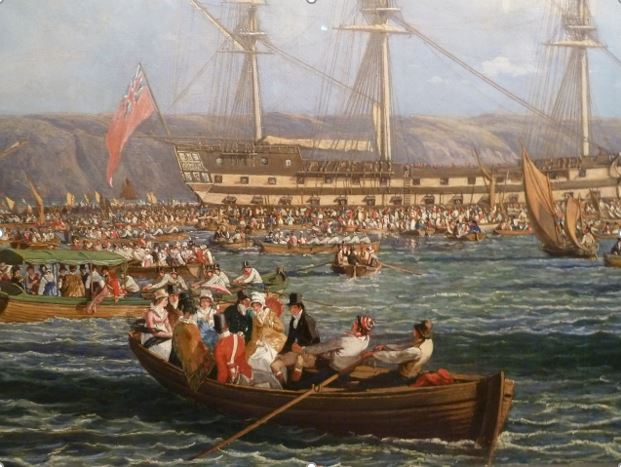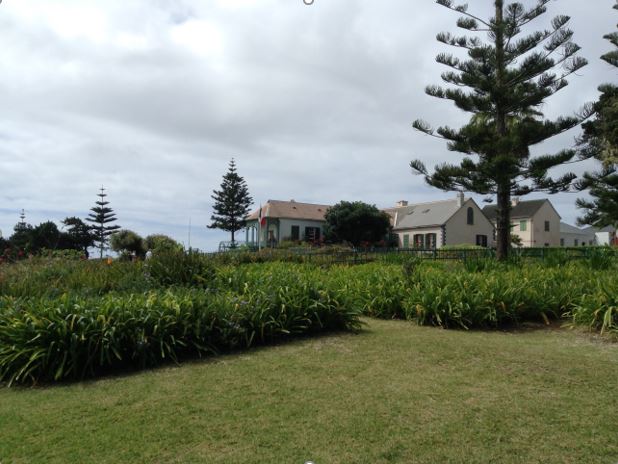- Author
- A.N. Other
- Subjects
- History - general, Biographies and personal histories
- Tags
-
- RAN Ships
- None noted.
- Publication
- September 2022 edition of the Naval Historical Review (all rights reserved)
By Fairlie Clifton
In 2021 at the time of the 200th anniversary of the death of Napoleon, the author of this article was reminded that Napoleon’s surrender to England had been received by Captain (later Rear-Admiral) Frederick Maitland RN. As her late partner was a Maitland, although not a descendant of Captain Maitland, this connection and the author’s maritime background led to the following account of the surrender and Napoleon’s subsequent interactions with the Royal Navy.
Maitland is a lowland Scottish clan, originally from Normandy. The Maitland family first came to prominence in Scottish affairs in the 16th and 17th centuries as lawyers and statesmen. In the 18th and early 19th centuries they had a distinguished record of colonial appointments and military service, mostly in the army. Two Maitlands, father and son both with the same name, served with distinction in the Royal Navy, the former in the American Revolutionary War and the latter in the Napoleonic Wars.
Captain Maitland the younger was a grandson of the sixth Earl of Lauderdale. He joined the Royal Navy as a midshipman aged 16 and moved rapidly up the ranks, achieving the rank of captain and his first command at the age of 24.
The 200th anniversary of the death of Napoléon Bonaparte on the remote island of St Helena in the South Atlantic Ocean, to which he had been exiled only two months after the Battle of Waterloo on 18 June 1815, occurred on 5 May 1821. While this is not a particularly nautical topic, it seems timely to review the surrender of Napoléon and his subsequent interactions with the Royal Navy.

In April 1815 Captain Frederick Maitland had taken command of HMS Bellerophon, a third rate 74-gun ship in a division of the Channel Fleet commanded by Vice-Admiral Henry Hotham. For years the Channel Fleet had the tedious task of blockading French Atlantic ports but by July 1815 excitement was in the air as it was rumoured that the deposed Emperor would try to escape to America. Bellerophon was patrolling off Rochefort near Bordeaux, assisted by two 20-gun frigates. For some three weeks the eyes of Europe were on Bellerophon, nicknamed ‘Billy Ruffian’ by her sailors, who had difficulty pronouncing the name of this Greek hero.
The defeated Napoléon retreated to Paris but unable to find political support was obliged to abdicate, resulting in the restoration of the Bourbon monarchy under King Louis XVIII. Napoléon then made for the coast, seeking to find exile in the United States or Britain.
He arrived in Rochefort and spent some days considering his next step. With the Royalists closing in and the Royal Navy blockade, he realised that he had little choice but to surrender to the British.

He believed that he could trust the British Government to allow him to live quietly in the country in England, as had one of his younger brothers, Lucien Bonaparte, a few years before. Negotiations then took place between his intermediaries and Captain Maitland, whose orders were simply to prevent Napoléon from escaping.
It was a week of intense pressure and anxiety for Captain Maitland for, until Napoléon finally came on board, he could not be sure that he would not attempt to escape to America via one of four French ships anchored in the roads. Bellerophon and her two frigates were on full alert as they patrolled the channels between the islands off Rochefort.
After lengthy discussions with Napoléon’s emissaries, arrangements were made for the boarding of Napoléon and his retinue of some 33 people, including 12 servants, and their baggage. Captain Maitland, his officers and crew did this calmly and efficiently, fully aware of the enormous responsibility placed upon them. Captain Maitland made his own cabin and the Great Cabin available to Napoléon. Throughout Bellerophon there was a sense of anticipation and excitement at the prospect of the man whom Britain had fought for the last twenty years coming on board. Every bit of brass received extra polishing and all lines were coiled down even more neatly than usual.
Early the next day, 15 July, Napoléon boarded with Generals Bertrand and Savary, the Countesses Bertrand and Montholon, and their young children, all of whom later went into exile with him. Other members and all their baggage boarded later. There was one initial dilemma for Captain Maitland; naval regulations did not include protocol for arrival on board of a recently deposed Emperor. By rights, a person of Napoléon’s status should have surrendered to an official of much higher rank, such as the Duke of Wellington or Admiral Hotham, who was still on his way to Rochefort and was not available for advice. Maitland decided on a low-key approach, with the marines drawn up on deck under arms but not presenting arms. It was a big day for the boatswain who piped Napoléon aboard; Maitland bowed and on Napoléon’s request introduced each of his officers. This was followed by breakfast down below.

Later in the morning Admiral Hotham arrived in his flagship, HMS Superb, and was pleased with Maitland’s actions. That evening the first of many grand dinners took place on Bellerophon, with a cheerful Napoléon as host and Admiral Hotham seated on his right, with the meals prepared by Napoléon’s cooks and served on the imperial silver-plate.
Admiral Hotham returned the hospitality the next day by inviting all present to breakfast on board Superb. This time Napoléon was accorded the honours reserved for royalty: sailors manned the yards, the ship’s company assembled on deck and marines provided a guard of honour, much to Napoléon’s delight. Superb’s officers were introduced and Sir Henry gave him a tour of the ship. Back on board Bellerophon it was General Bertrand’s turn to host dinner, and a jovial affair it was, all present seeming happy. Napoléon was cheerful and friendly and once under way and heading for Plymouth took a great interest in the workings of the ship. He talked amicably to the sailors about their work and remarked on their ‘orderly conduct’ and ‘extreme silence’ unlike on French ships where, he said, ‘everyone calls and gives orders and they gabble like so many geese’.
From all accounts Captain Maitland handled the negotiations leading to Napoléon’s surrender with the utmost courtesy and impeccable diplomacy and was highly respected by Napoléon. He and his officers dined formally every night with their French guests and on one night Bellerophon’s officers performed a play for their entertainment.
Bellerophon’s arrival at Torbay near Plymouth was intended to be top secret but despite Captain Maitland forbidding anyone to leave the ship, word got out, headlines were splashed in the newspapers, and thousands of citizens in small boats surrounded the ship. While at anchor, Napoléon appeared on deck every day at 6 pm and acknowledged the crowd. By now he was aware of the rumours that he was to be exiled to St Helena, and he became ill and depressed. Meanwhile, the number of small boats around the ship had not diminished and the situation was becoming chaotic. Bellerophon was ordered to sea, away from the crowds.

On 31 July Admiral Viscount Keith, C-in-C Channel Fleet, came on board with the Under Secretary of State for War to convey the British Government’s decision to exile Napoléon to St Helena. He would be transferred in a few days to HMS Northumberland, another 74-gun ship of the line, for the two-month voyage, Bellerophon being considered too old for such a long voyage. An angry Napoléon protested vigorously and claimed that Botany Bay would be better than St Helena. However, he was informed that the decision was final and no further discussion would be entered into. From now on he would be treated as a General and not an Emperor.
In June, before Napoléon’s surrender, Rear Admiral Sir George Cockburn had been appointed C-in-C Cape of Good Hope, which included St Helena. He had now received orders to accompany Napoléon to St Helena, spend six months there establishing accommodation and other matters for him and his party and, importantly, setting up tight security to ensure that there was no possibility of escape. He would then travel on to Cape Town after handing over to a new Governor of St Helena, Major-General Sir Hudson Lowe. Admiral Cockburn not only had the rank and experience for these tasks but also ‘an energy of character’ and ‘zeal, ability and discretion’ needed to manage this most important of prisoners and enforce compliance with the British Government’s conditions, while at the same time maintaining the defeated Emperor’s cooperation.
The next week, while waiting for Northumberland to arrive, was a difficult one for all on board. Napoléon became increasingly depressed, shut himself in his cabin, did not shave and looked ill, and he bombarded Captain Maitland with protests. The French party on board received the news of the exile with great distress, and Madame Bertrand attempted suicide by throwing herself into the sea. She was pulled back before she could do so. Even the crew, still unable to communicate with anyone on shore, were becoming impatient.
Back in Torbay arrangements were finalised for the transfer of Napoléon to Northumberland on 7 August together with some thirty members of the French party and their baggage. Several boatloads of luggage and personal effects were transferred, the baggage having been thoroughly searched beforehand, which offended the French. There were emotional farewells between Napoléon and those of his followers who were staying behind. When he appeared on deck, pale and drawn, the entire crew of Bellerophon lined the decks and in silence watched their famous passenger who had made a favourable impression on many of them during his time on board. Before walking to the gangway Napoléon went up to Captain Maitland to express his thanks, turned to the officers to thank them and finally before stepping on to the gangway, turned to the sailors, took off his hat and bowed. He was then rowed away, sitting between Lord Keith and Admiral Cockburn.
Accommodation was tight and after a day to settle in Admiral Cockburn’s flag was hoisted on Northumberland. On 9 August 1815 she sailed into the English Channel at the head of a convoy consisting of the frigate HMS Havannah, two troopships carrying troops of the 53rd Regiment, and five other armed ships loaded with stores.
The voyage to St Helena was uneventful but ‘managing’ a man who had wanted to control the world was not easy. Napoléon regarded himself as Emperor, was treated as such by his entourage, and expected the same from everybody else including Cockburn. As far as Admiral Cockburn and the British Government were concerned, Napoléon was a defeated General and was to be treated as such.
During the first weeks Napoléon was dejected, moody, sulky and sometimes quite arrogant but the relationship with Admiral Cockburn settled down, largely on account of Cockburn’s equanimity and steady refusal to be influenced by Napoléon’s attention-seeking behaviour. His skill in balancing his roles as gaoler and host was later praised by the Prince Regent and Parliament. Neither admired the other but each night the two met at the dinner table, when there was free flowing conversation in which the Admiral’s fluent French was an advantage, followed by an hour or more of cards.
After 67 days at sea it was a relief for all to sight St Helena but with mixed feelings, for the island and its ‘stupendous barren cliffs’ were ‘horribly forbidding’. It was with a heavy heart that on 16 October Napoléon landed on this island from which he would probably not return.
On landing at Jamestown, the principal settlement, accommodation for the French party and the troops was not ready, and both had to make do with temporary accommodation for two months. Longwood House, some distance away from the town, had to be made habitable for the French, and barracks had to be built for the troops who were to guard it. A priority for Admiral Cockburn was establishment of the security measures specified by the British Government:
Sentries posted on the boundaries of Longwood House
On outings beyond the boundaries Napoléon to be accompanied by an English officer and orderly
Outings to be banned if any strange ships were in sight of the island
Communication with islanders forbidden
Letters to Napoléon and his followers to be read by Cockburn before delivery
Ditto outward correspondence
Complaints on treatment to be referred to London, accompanied by the comments of Cockburn or the incoming Governor later on
Twice every 24 hours Napoléon had to be sighted and his presence reported to Admiral Cockburn
Sentries at the lodge gate could admit only those few issued with a pass
Troops to be stationed at all potential landing places
Guard boats constantly patrolled to windward and leeward of the island
All private boats to be secured at sunset and given an armed guard
Every bridge and gate inland to be closed and locked at sunset
A 9 pm curfew applied to every person in Jamestown and to Napoléon’s household.
St Helena was a regular port of call for English ships returning from the east, and the arrival and departure of every ship was closely observed. Any landing from these ships had to be approved first. Foreign naval and merchant vessels were forbidden from calling at the island while Napoléon was there. The British were determined that he should be incarcerated for good, and this heavily fortified island, 2000 km from Africa and 3000 km from Brazil, was the ideal place. The island was thus sealed off from the rest of the world and was completely controlled by Admiral Cockburn and his successor.
All this placed considerable strain on the island’s resources and stores, particularly building materials. Some goods could be purchased from the East India Company, which administered the island, but at ‘an exorbitant price’. Additional supplies had to be obtained from Cape Town and Brazil.
Tirade after Tirade
Far from being reconciled to their fate, the French launched tirade after tirade against the British Government. Their grievances included the barrenness and lack of water around Longwood House, and the furniture which, they said, ‘seems to have been composed of articles grown old in waiting rooms’. Particularly upsetting for the French party was the shortage of good wine; however, they were able to obtain and consume enough Constantia wines from the Cape to arouse protests from the St Helena Governor at the expense. Napoléon’s favourite was the great vintage Groot Constantia.
Napoléon never ceased to rage against his gaolers for the illegality of his exile on St Helena and his treatment as a General instead of Emperor. While he was permitted to ride out to most of the island, he refused to suffer the indignity of having to be accompanied by an English guard outside the Longwood estate. He died of stomach cancer on 5 May 1821 at the relatively young age of 51 and was interred in a lush green valley not far from Longwood and which he himself had selected for his tomb. It was a dignified ceremony, with the entire British garrison lining the route and presenting arms as the hearse passed by.
There were immediate appeals by his French companions for the return of his body to France but it was not until nineteen years later that King Louis-Philippe of France decided that this should be done – Le Retour des Cendres (‘cendres’ meaning ‘mortal remains’ in this context, not ashes) in 1840. This event generated much soul-searching in England regarding the morality of Napoléon’s exile and imprisonment as a General.
On 8 October 1840 the first rank 60-gun French frigate La Belle Poule, painted black for this sombre voyage, arrived off Jamestown. On board were Prince Philippe of France and two of Napoléon’s most faithful companions at Longwood House, Marshal Bertrand and General Gourgaud, who conferred with the authorities over details of the ceremony to take place. First, it was decided that the body should be inspected. After levering heavy stone slabs away and cutting through three coffins, the last a hermetically sealed lead coffin, the body was found to be perfectly preserved. The coffin, covered by a splendid, richly decorated pall, was then slow-marched down to the waterfront with great solemnity, accompanied by a large number of French and British officers and the firing of minute guns.
Of course, once again the British and the French could not agree on the ensuing ceremonial procedures. The Governor of the island had fought in the Peninsula War and wanted nothing to do with organising the ceremony. Under pressure from the French, the army fired a 103-gun Emperor’s royal salute from the battery above Jamestown. Captain Littlehales of the duty ship HMS Dolphin, however, would have none of this, and ensured that ‘General Bonaparte’ received only a 21-gun salute. Belle Poule of course fired a royal salute. During the French salute an English merchant ship appeared around the point, and thinking that war had been declared and that she was being attacked, put about and fled for her life.
On 16 October 1840 Belle Poule wasted no time in departing from the island as soon as the coffin was loaded. The haste may have had something to do with the latest available news which indicated that England and France were at loggerheads over Syria, and there was a threat of war. As soon as the ship reached the three-mile territorial limit, she was cleared for action. Dolphin followed her out at a safe distance, with Captain Littlehales determined to fire a shell or two into ‘old Boney’s coffin’ if he got the chance. Fortunately, he did not get that chance.
In life and in death Napoléon attracted both admiration and hatred in France and Britain and was controversial to the last. On arrival in France his coffin was offloaded and conveyed up the River Seine to Paris, where a spectacular funeral took place. Even in Paris there was controversy about the funeral arrangements and selection of the place of interment, and on the day Royalist troops were posted around the city in case of riots. However, all passed off peacefully, and Napoleon’s tomb is beneath the dome of Les Invalides.
On St Helena nowadays the French tricolor is always flown on the Longwood House flagstaff, and on 5 May every year there is a ceremony at the site of Napoléon’s tomb to commemorate his death. The French consul attends and the local high school choir sings the Marseillaise. On 5 May this year there were commemorations on 5, 6 and 9 May.
Sources
Fondation Napoléon, Paris: 2021 Année Napoléon newsletters
Cordingly, David. Billy Ruffian – The Bellerophon and the Downfall of Napoléon. Bloomsbury 2003
The Naval Chronicle for 1815: Vol.34 – July-December 1815
The Naval Chronicle for 1816: Vol.36 – July-December 1816
The Naval Chronicle for 1817: Vol.38 – July-December 1817
Letter from Lieutenant (later General Sir) John Lefroy RA to his sister 17 October 1840 – edited by A.D. Thiessen




